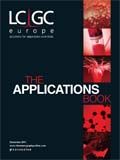Extraction of Benzodiazepines From Human Urine Using ISOLUTE SLE+ 96-Well Plates and Columns prior to LC–MS/MS Analysis
Biotage Application Note
This application note describes the extraction of a range of benzodiazepines from human urine using ISOLUTE SLE+ supported liquid extraction plates (96-well) and columns prior to LC–MS/MS analysis. Supported liquid extraction is an efficient and cost-effective alternative to traditional liquid-liquid extraction (LLE) for bioanalytical sample preparation, providing high analyte recoveries, no emulsion formation and significantly reduced sample preparation time.
Extraction Conditions
This application note outlines the procedure using both the ISOLUTE SLE + 1 mL sample volume column (part number 820-0140-C) optimized for a 1 mL pretreated urine sample volume and the ISOLUTE SLE+ 96-well extraction plate (part number 820-0200-P01) optimized for a 200 µL pre-treated sample. Method parameters and dilution factors have been optimized to maximize recoveries and minimize ion suppression.

Table 1: MRM transitions in positive mode and detected LOQs for a range of benzodiazepines.
Sample pre-treatment: To 1 mL of urine add 100 mM ammonium acetate pH 5 (950 µL) and -glucuronidase (50 µL) enzyme (~4500 u/mL). Hydrolyze in a water bath at 60 °C for 2 h. 50 µL of enzyme is required per mL of urine used. For a 200 µL sample use ISOLUTE SLE+ 200 Supported Liquid Extraction plate, part number 820-0200-P01.
Sample load: Load pre-treated sample (200 µL) to plate followed by a pulse of vacuum to initiate flow and leave for five min to completely adsorb.
Analyte elution: Elute with dichloromethane (1mL). Leave to flow under gravity for five min, then apply short pulse of vacuum.
Post extraction: Evaporate to dryness at room temperature (80 L/min) and reconstitute in HPLC grade water/acetonitrile (70/30,v/v) (200 µL). Cap with sealing mat and vortex gently (60 s).
For a 1 mL sample use ISOLUTE SLE + 1 mL sample volume column, part number 8200140C.
Sample load: Load pre-treated sample (1 mL) to plate followed by a pulse of vacuum to initiate flow and leave for five min to completely adsorb.
Analyte elution: Elute with dichloromethane (2.5 mL). Leave to flow under gravity for five min, then follow with a further aliquot of dichloromethane (2.5 mL), apply a short pulse of vacuum.
Post extraction: Evaporate to dryness at room temperature (80 L/min) and reconstitute in HPLC-grade water/acetonitrile (70/30, v/v) (1 mL). Vortex gently (60 s).
HPLC Conditions
Instrument: Waters Alliance 2795
Column: Phenomenex Kinetex C18 100 Å column (2.6 µm, 50 x 2.1 mm id)
Mobile phase: 0.1% formic acid (aq)/acetonitrile (70/30, v/v) (isocratic)
Flow rate: 0.30 mL/min
Injection: 25 µL (partial loop)
Sample temp: 20 °C
Column temp: Ambient
Mass Spectrometry Conditions
Instrument: Waters Ultima Pt triple quadrupole mass spectrometer equipped with an electrospray interfacefor mass analysis
Source temp: 100 °C
Desolvation temp: 350 °C
Results
Extracted samples demonstrated consistent recoveries between 85-110% with RSDs below 10%. Lowest LOQ demonstrated was 100 pg/mL for at least four analytes and this could be improved with more sensitive mass spectrometry.

Figure 1: Average analyte recoveries of benzodiazepines analytes on 96 fixed well plates at 10 ng/mL (n=7).
Conclusions
This method demonstrates a robust and effective extraction of a full range of benzodiazepines from the challenging biological matrix of human urine with hydrolysis. The hydrolysis step shown here used the enzyme helix pomatia but other enzymes can be used with no loss of efficacy of the application.
Biotage AB
Kungsgatan 76, SE-753, 18, Uppsala, Sweden
tel: +46 18 56 59 00 fax: +46 18 59 19 22
E-mail: info@biotage.com Website: www.biotage.com

New Method Explored for the Detection of CECs in Crops Irrigated with Contaminated Water
April 30th 2025This new study presents a validated QuEChERS–LC-MS/MS method for detecting eight persistent, mobile, and toxic substances in escarole, tomatoes, and tomato leaves irrigated with contaminated water.
University of Tasmania Researchers Explore Haloacetic Acid Determiniation in Water with capLC–MS
April 29th 2025Haloacetic acid detection has become important when analyzing drinking and swimming pool water. University of Tasmania researchers have begun applying capillary liquid chromatography as a means of detecting these substances.

.png&w=3840&q=75)

.png&w=3840&q=75)



.png&w=3840&q=75)



.png&w=3840&q=75)










